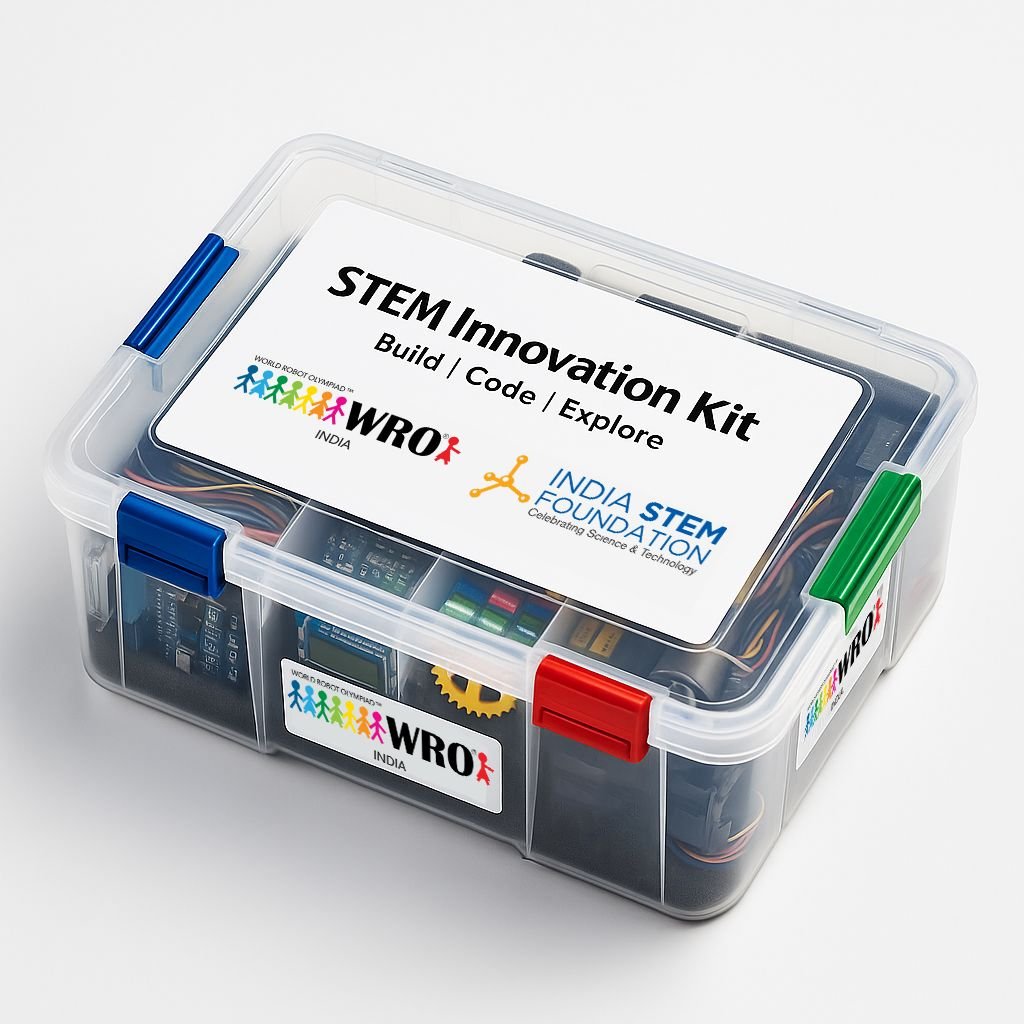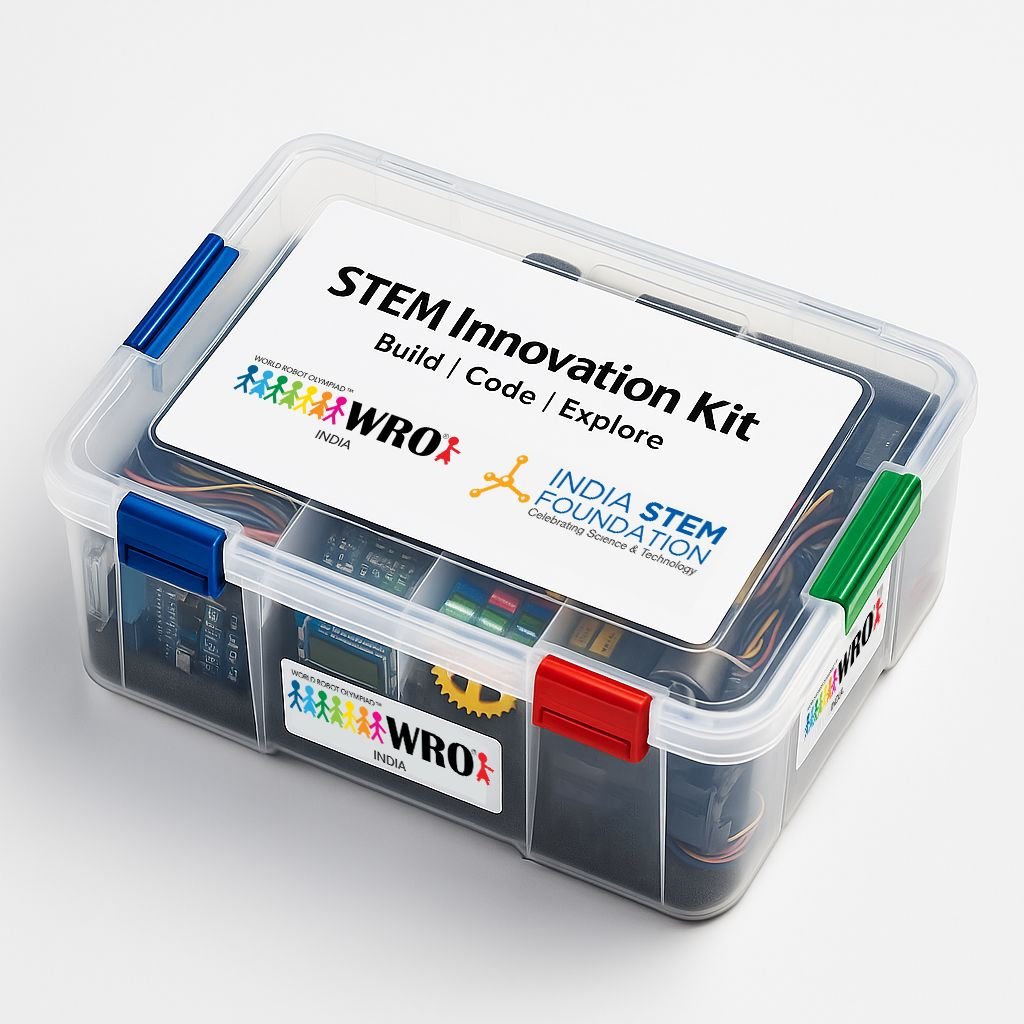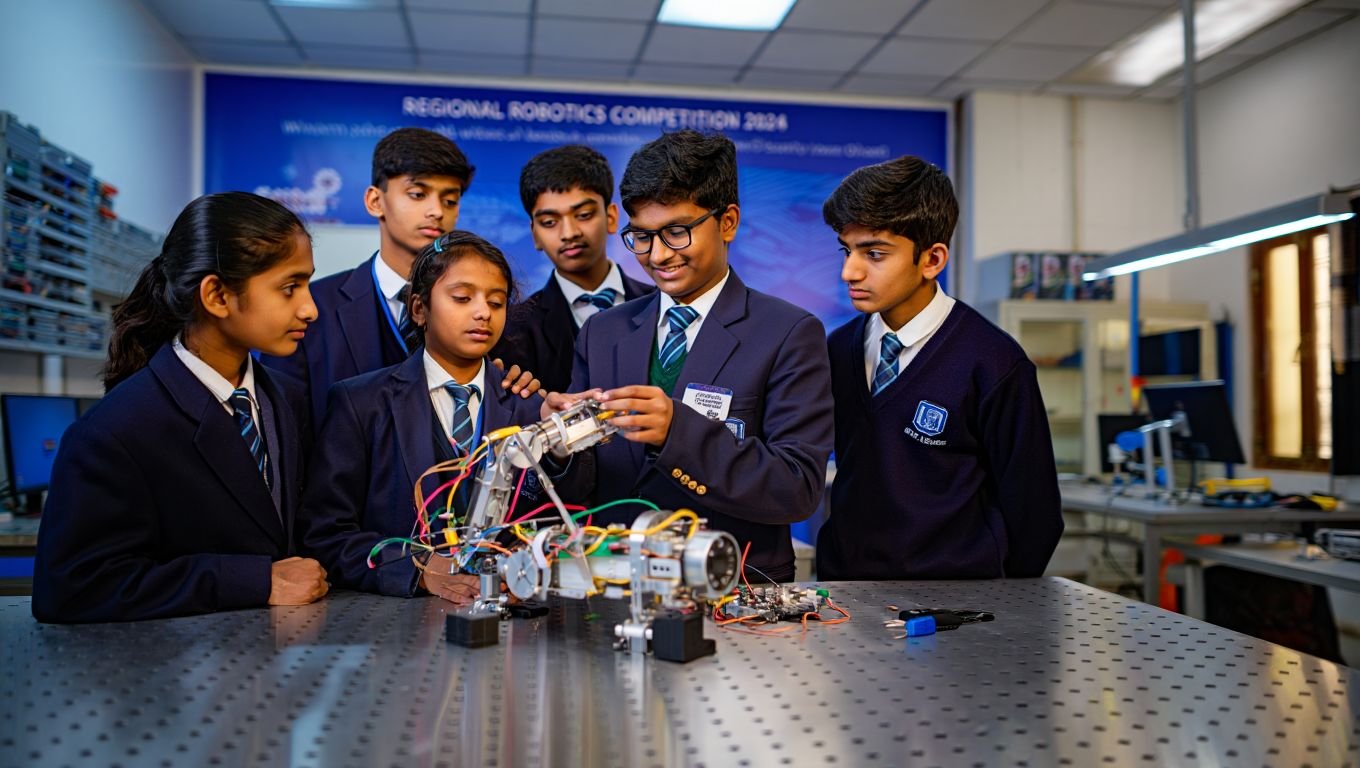Introduction
In an era characterized by rapid technological advancement, complex global challenges, and an ever-evolving job market, the traditional paradigms of education are proving increasingly inadequate. To thrive in this dynamic environment, students must be equipped not merely with academic knowledge, but with interdisciplinary competencies that enable them to innovate, analyze, and adapt. STEM education—an integrated approach to teaching Science, Technology, Engineering, and Mathematics—has emerged as a transformative model that aligns with these imperatives. It transcends the conventional compartmentalization of subjects, fostering a learning culture rooted in inquiry, hands-on experimentation, and problem-solving. In a country like India, home to one of the youngest populations in the world, the strategic implementation of STEM education holds unparalleled potential. It not only serves as a vehicle for academic excellence but also as a catalyst for socio-economic progress and global competitiveness.
Recognizing the profound potential, the India STEM Foundation has taken a pioneering role in STEM education. The foundation is redefining how STEM is delivered and experienced in Indian classrooms.
Through its wide-ranging initiatives, including the establishment of Atal Tinkering Labs, Roboshiksha Kendras, and Certified STEM Teacher Training Programs, the Foundation is bridging the gap between theoretical learning and real-world application.
Its mission is to make STEM education more accessible. The Foundation also aims to democratize innovation, reaching underserved and underrepresented communities.
The benefits of STEM education are both immediate and far-reaching. These include enhanced cognitive and analytical skills, increased student engagement, and improved employability. STEM education also strengthens the pipeline of talent for emerging industries.
As India aspires to become a global leader in science and technology, fostering a robust STEM ecosystem is crucial. It is not merely an educational priority but a national necessity.
This article explores the multifaceted advantages of STEM education in India. It also highlights the critical role played by the India STEM Foundation in nurturing the next generation of innovators, problem-solvers, and change-makers.
What is STEM Education?
STEM education is a progressive and interdisciplinary approach that integrates Science, Technology, Engineering, and Mathematics into a unified curriculum. Unlike traditional methods, which treat these subjects separately, STEM emphasizes real-world applications, critical thinking, and collaborative problem-solving.
By engaging students in hands-on experiments, project-based learning, and technology-driven activities, STEM fosters curiosity and innovation. It also helps students understand how the world works. This approach strengthens their academic foundation and prepares them for careers in high-demand fields such as artificial intelligence, robotics, data science, biotechnology, and sustainable engineering.
In today’s digital age, industries are evolving rapidly, and new technologies are constantly emerging. The demand for STEM-literate individuals is higher than ever. Implementing STEM education in India is crucial, as it empowers students to become creators of technology rather than just consumers.
STEM education nurtures a generation capable of addressing complex global challenges. Institutions like the India STEM Foundation are playing a critical role in expanding access to STEM learning across schools in India. They ensure that students from all backgrounds benefit from this transformative educational model.
Through robotics labs, coding workshops, and innovative classroom activities, STEM education is shaping the future of learning—and the future of India.
The Role of the India STEM Foundation
In the realm of progressive education reform, the India STEM Foundation stands as a vanguard institution. It champions equitable access to quality STEM education across the nation. The Foundation recognizes the transformative power of STEM in catalyzing both individual growth and national development. It has strategically positioned itself at the intersection of education, innovation, and social impact.
The Foundation’s core mission revolves around empowering students—especially from underserved and underrepresented communities. It equips them with the skills and mindset necessary to thrive in an increasingly tech-centric global economy.
India STEM Foundation promoting STEM education and its benefits
The India STEM Foundation has pioneered a variety of initiatives that bridge the gap between theoretical learning and practical application. Through programs like Atal Tinkering Labs (ATL) and Roboshiksha Kendra, the Foundation facilitates experiential learning environments. These programs inspire curiosity, critical inquiry, and design thinking from an early age.
The hands-on, technology-enabled spaces provide students the opportunity to explore robotics, electronics, automation, and artificial intelligence. These subjects are essential in the Fourth Industrial Revolution.
Moreover, the Foundation’s Certified STEM Teacher Training Programs play a crucial role in capacitating educators. These programs equip teachers with the pedagogical tools and digital fluency necessary to deliver high-impact, student-centered learning experiences.
What truly distinguishes the India STEM Foundation is its inclusive, scalable model. This model aligns seamlessly with the National Education Policy (NEP) and global benchmarks in STEM pedagogy.
By forging strong collaborations with government agencies, corporates, academic institutions, and international organizations, the Foundation ensures that its programs are innovative, sustainable, and far-reaching. These initiatives transcend geographic and socio-economic barriers, making high-quality STEM education a reality for countless students across urban and rural regions.
The Foundation’s unwavering commitment to nurturing future-ready talent has led to measurable improvements. Students have shown increased engagement, academic performance, and participation in global platforms like The World Robot Olympiad (WRO) and FIRST LEGO League.
As a trailblazer in the STEM ecosystem, the India STEM Foundation continues to redefine what is possible in education. It doesn’t just prepare students for the jobs of tomorrow. It inspires them to become the architects of a better, more technologically empowered world.
Key Benefits of STEM Education
The advantages of incorporating STEM education into mainstream academic frameworks are multifaceted and far-reaching. This interdisciplinary approach not only strengthens academic rigor but also cultivates the essential cognitive and technical competencies needed for the 21st-century workforce. Below are some of the most profound benefits of STEM education, particularly in the context of a rapidly evolving global and national economy like India’s.
Fostering Analytical Thinking and Complex Problem-Solving
STEM education emphasizes inquiry-based learning and logical analysis, encouraging students to approach problems through a structured and methodical lens. Learners are trained to dissect complex scenarios, hypothesize outcomes, and design innovative solutions using scientific and mathematical principles. This nurtures a mindset that thrives in ambiguity and embraces challenges as opportunities for growth—an essential quality in both academic pursuits and real-world applications.
Promoting Innovation and Technological Fluency
One of the most salient benefits of STEM education is its ability to spark innovation and cultivate a deep understanding of emerging technologies. By engaging with disciplines such as robotics, coding, artificial intelligence, and engineering design, students acquire digital literacy and technological fluency at an early stage. This not only prepares them for careers in future-focused industries but also empowers them to become inventors, entrepreneurs, and thought leaders in their respective fields.
Enhancing Interdisciplinary Learning and Real-World Application
STEM education dissolves the artificial boundaries between subjects, promoting holistic learning that reflects the interconnectedness of real-world phenomena. Another benefit of STEM education is that, it promotes, project-based learning and collaborative experimentation, students gain the ability to apply scientific concepts in practical settings—be it through designing a prototype, simulating an engineering process, or analyzing data for environmental impact. This experiential pedagogy makes learning more relevant, immersive, and impactful.
Encouraging Creativity and Cognitive Flexibility
Contrary to the common misconception that STEM is purely analytical, this educational model deeply values creative problem-solving and divergent thinking. Students are encouraged to think outside the box, generate multiple hypotheses, and explore unconventional solutions. This blend of logic and imagination enhances cognitive flexibility—an essential skill in an age of automation, where adaptability is as important as expertise.
Bridging the Skills Gap and Boosting Career Readiness
As industries undergo rapid digital transformation, there is a growing chasm between the skills taught in traditional education and those demanded by the modern workforce. STEM education in India plays a pivotal role in bridging this divide by equipping students with industry-relevant skills such as coding, data analysis, systems thinking, and engineering principles. This not only enhances employability but also ensures a steady pipeline of talent for sectors driving India’s economic growth, including information technology, biotechnology, aerospace, and renewable energy.
Promoting Equity and Inclusive Educational Opportunities
By democratizing access to high-quality learning resources, STEM education serves as a powerful tool for social mobility. Programs driven by institutions like the India STEM Foundation are instrumental in bringing STEM exposure to underprivileged and marginalized communities. These efforts foster inclusivity, reduce educational inequity, and ensure that talent and curiosity—not socio-economic status—define a child’s educational trajectory and future opportunities.
Cultivating Global Competence and Scientific Temperament
In an interconnected world, it is imperative for students to think globally and act locally. STEM education equips learners with a scientific mindset—grounded in evidence, experimentation, and ethical reasoning. It fosters an awareness of global challenges such as climate change, health pandemics, and sustainable development, and empowers students to contribute meaningfully through innovation and research. This global competence, coupled with a strong foundation in STEM, positions students to become conscientious global citizens and change agents.
Impact of stem education
The true measure of any educational reform is its ability to produce tangible outcomes. The impact of STEM education in India is evident in the inspiring stories of transformation across the nation. These transformations are taking place in classrooms, innovation labs, and competitive arenas.
The India STEM Foundation has made dynamic, hands-on learning experiences possible. Thousands of students and educators have begun to reimagine what’s possible—not just in academics, but in life.
One of the clearest indicators of success is the growing participation of Indian students in prestigious robotics competitions. These include the World Robot Olympiad (WRO) and FIRST LEGO League. Students, many from modest socio-economic backgrounds, have designed, built, and programmed robots.
These robots solve complex challenges such as environmental sustainability and space exploration. Platforms like WRO and FIRST LEGO League have become springboards for innovation, confidence-building, and global exposure.
Real world impact of STEM Teacher training
Schools partnering with the India STEM Foundation have seen increased student engagement, curiosity, and academic performance. This is especially true in science and mathematics.
Teachers trained under the Foundation’s Certified STEM Teacher Training Program have adopted a more experiential and inquiry-based pedagogy. They have transformed their classrooms into vibrant hubs of creativity and exploration.
These educators report improved student outcomes. They also describe a personal sense of professional growth and rejuvenation.
In rural and semi-urban regions, access to advanced learning tools was once a distant dream. However, the Foundation’s initiatives have changed that. They have brought cutting-edge technology into the hands of eager learners.
There are countless stories of students from remote areas creating solar-powered devices. Others have designed water conservation systems or automated household tools—all while still in school.
These are not isolated incidents. They are part of a growing movement. This movement reflects the real-world success of STEM education in India.
Furthermore, the ripple effect of such interventions is being felt in the broader community. Parents, who once saw education as a rigid, textbook-oriented process, are now witnessing their children build drones, code apps, and win competitions. This shift is inspiring families and communities to value innovation and education in new ways, fostering a culture of learning that extends far beyond the classroom walls.
The India STEM Foundation continues to document and share these success stories to inspire more schools, educators, and policymakers to adopt STEM learning. Through a strategic blend of access, mentorship, and opportunity, it is not only bridging the educational divide but actively shaping a generation of empowered, tech-savvy, and socially conscious young citizens.
These stories of transformation stand as living proof that with the right guidance and resources, STEM education can unlock unimaginable potential. It is no longer just about preparing for the future—it is about creating it, one student at a time.
Challenges and Opportunities in India
While the adoption of STEM education in India has gained significant momentum, its large-scale implementation is not without hurdles. A country as vast and diverse as India presents a unique set of challenges—but these also open the door to transformative opportunities. Understanding these dynamics is crucial for educators, policymakers, and organizations aiming to build an inclusive and future-ready education ecosystem. Here are the challenges in the implementation of STEM Education
Infrastructure Disparities Across Urban and Rural Areas
One of the most pressing challenges, however, is the stark infrastructural divide between urban and rural schools. While metropolitan institutions are often equipped with advanced laboratories, internet connectivity, and modern teaching aids, many rural schools, unfortunately, continue to struggle with basic educational resources. As a result, the absence of dedicated STEM labs, hands-on learning tools, and digital platforms significantly limits the ability of students in rural areas to fully engage with STEM learning. Consequently, this disparity in infrastructure not only hampers their access to high-quality education but also stifles innovation and growth in these regions.
Shortage of Skilled STEM Educators
Another major barrier lies in the scarcity of trained and competent STEM educators. The traditional teacher training programs in India often lack focus on interdisciplinary learning, digital pedagogy, and emerging technologies. As a result, teachers may feel ill-equipped to deliver engaging and experiential STEM lessons. The gap between curriculum and capability hampers the overall effectiveness of STEM instruction.
Socio-Economic and Gender Inequality
Access to STEM education is often influenced by socio-economic factors, with students from marginalized communities and remote regions having fewer opportunities to participate. Additionally, gender stereotypes persist, discouraging many young girls from pursuing careers in STEM fields. Bridging this divide requires intentional, inclusive strategies that promote equity and representation.
Curriculum Rigidities and Exam-Oriented Learning
The rigidity of the current academic curriculum and the heavy emphasis on rote memorization and high-stakes examinations pose significant obstacles. STEM education, which thrives on creativity, critical thinking, and experimentation, often takes a backseat in a system where academic performance is narrowly defined by test scores.
Here are the opportunities for growth and transformation
Leveraging Technology for Scalable Solutions
India’s growing digital infrastructure presents immense potential to overcome geographical and economic barriers. With the rise of edtech platforms, virtual labs, and AI-driven learning tools, quality STEM education can now reach students in the remotest corners of the country. Online teacher training modules and cloud-based resources can democratize access to high-quality content and instruction.
Policy Support and National Initiatives
Government-backed initiatives such as the National Education Policy (NEP) 2020, Atal Innovation Mission (AIM), and the establishment of Atal Tinkering Labs are significant. They reflect a strong policy shift towards experiential learning and innovation.
These frameworks help create a fertile environment for integrating STEM education into mainstream schooling. The focus is on creativity, coding, and critical thinking from the foundational years.
Industry and NGO Collaborations
Organizations like the India STEM Foundation are playing a pivotal role in addressing educational gaps through strategic partnerships with corporates, academic institutions, and government bodies. Their initiatives offer practical exposure, hands-on training, and real-world project opportunities, enabling students to connect classroom learning with global challenges. Such collaborations also help align education with industry demands, creating a more employable and innovative youth workforce.
Rising Interest in Future-Ready Skills
With the advent of Industry 4.0, there is a growing awareness. Parents, students, and educators are becoming more aware of the importance of future skills. These skills include automation, robotics, data science, and sustainability.
This shift in mindset is driving demand for STEM education in India. It is creating momentum for curriculum innovation and broader educational reform.
India stands at a pivotal juncture. It can redefine the future of its youth through inclusive and high-impact STEM education. While the challenges are significant, the opportunities are even greater.
By investing in teacher capacity, digital infrastructure, and inclusive educational policies, India can unlock its demographic dividend. Supporting the pioneering work of institutions like the India STEM Foundation is key.
The road ahead demands collaboration, innovation, and sustained commitment. Every child, regardless of background, must have access to the tools to become a creator, thinker, and leader in the global STEM landscape.
Conclusion to the benefits of STEM Education
STEM education is not merely an academic framework. It is a transformative force. It holds the key to unlocking the full potential of India’s youth.
In an age where innovation drives progress and technology shapes every aspect of human life, the integration of science, technology, engineering, and mathematics into the heart of education is no longer optional. It is essential.
By fostering curiosity, resilience, and critical thought, STEM education equips students. It prepares them to become not just job-seekers, but creators, leaders, and problem-solvers. These individuals will be capable of addressing the complex challenges of the 21st century.
The future of India lies in classrooms where students are encouraged to question, explore, build, and innovate. To realize this vision, we must reimagine education as a dynamic, inclusive, and forward-looking process. This process must nurture every child’s innate potential, regardless of their background.
Institutions like the India STEM Foundation exemplify the impact of visionary efforts. They are making this dream a reality.
As educators, policymakers, parents, and change-makers, the responsibility rests upon us. We must champion STEM education, not as a privilege, but as a right. It is time to invest in infrastructure and curriculum. But we must also invest in a culture of learning. A culture that celebrates experimentation, values diversity, and fuels imagination.
By doing so, we are not just preparing students for future careers. We are empowering them to shape the future itself.




